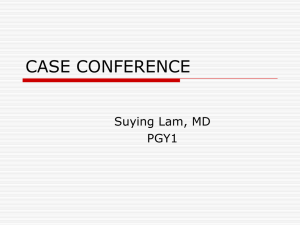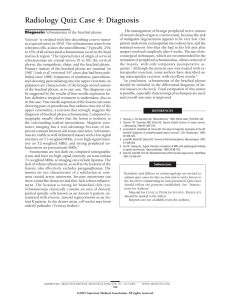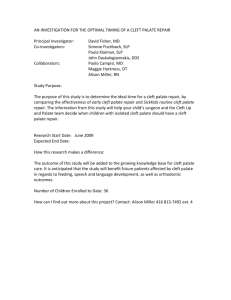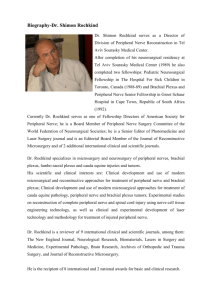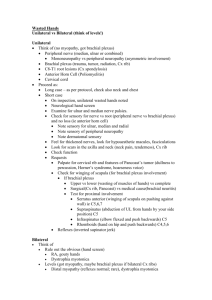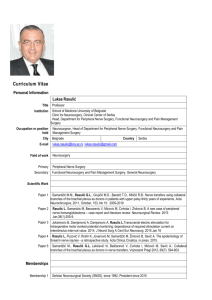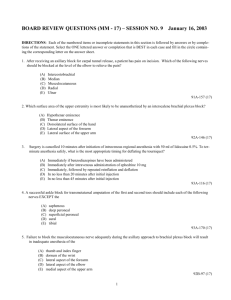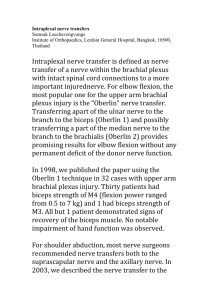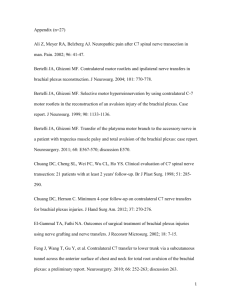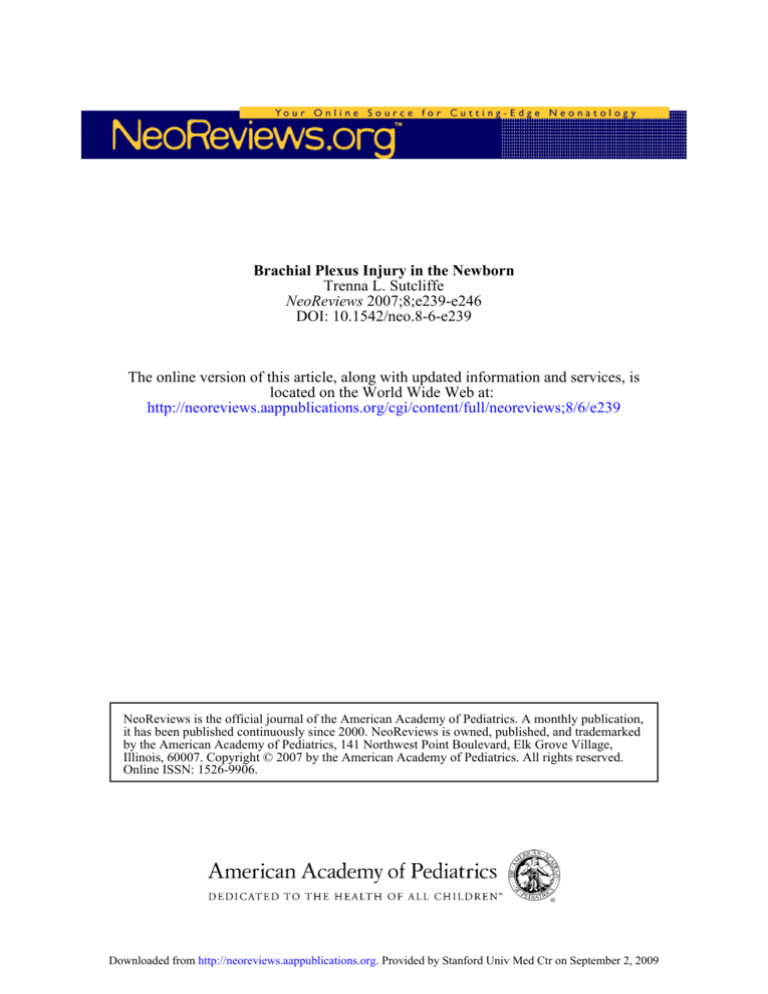
Brachial Plexus Injury in the Newborn
Trenna L. Sutcliffe
NeoReviews 2007;8;e239-e246
DOI: 10.1542/neo.8-6-e239
The online version of this article, along with updated information and services, is
located on the World Wide Web at:
http://neoreviews.aappublications.org/cgi/content/full/neoreviews;8/6/e239
NeoReviews is the official journal of the American Academy of Pediatrics. A monthly publication,
it has been published continuously since 2000. NeoReviews is owned, published, and trademarked
by the American Academy of Pediatrics, 141 Northwest Point Boulevard, Elk Grove Village,
Illinois, 60007. Copyright © 2007 by the American Academy of Pediatrics. All rights reserved.
Online ISSN: 1526-9906.
Downloaded from http://neoreviews.aappublications.org. Provided by Stanford Univ Med Ctr on September 2, 2009
Article
neurology
Brachial Plexus Injury in the
Newborn
Trenna L. Sutcliffe, MD,
MSc, FRCPC*
Author Disclosure
Dr Sutcliffe did not
disclose any financial
relationships relevant
Objectives
After completing this article, readers should be able to:
1. Distinguish among perinatal brachial plexus palsy (PBPP) classification categories based
on clinical findings.
2. Identify risk factors for PBPP.
3. Describe other injuries commonly seen in infants who have PBPP.
4. Evaluate clinical features that predict long-term outcome.
5. Assess the need for referral to a specialized clinic.
to this article.
Abstract
Brachial plexus palsy in the neonate is classified according to the anatomic location and
type of injury. Upper plexus lesions are observed most frequently. The overall rate of
perinatal brachial plexus palsy (PBPP) has remained stable for the last 3 decades,
although risk factors for the injury are well described. The true rate of full recovery
after PBPP remains controversial. Knowledge of an infant’s PBPP classification can
assist in predicting long-term outcome. A thorough physical examination is essential
to make the diagnosis, evaluate for comorbidities, determine the treatment plan, and
assess the need for referral. Additional investigations typically are not indicated. Initial
management of the infant who has PBPP includes parent counseling, physical or
occupational therapy, and clinical observation of the infant. A proportion of affected
infants eventually requires surgical intervention or alternative therapeutic approaches,
including botulinum toxin injections.
Introduction
Perinatal brachial plexus palsy (PBPP) is a peripheral nerve injury detected in the newborn.
It is commonly but not exclusively associated with a traumatic birth and potentially can
lead to long-term disability. Physicians who care for newborns should be familiar with the
presenting signs, comorbid conditions, and prognosticating features. Historically, PBPP
injuries have been classified with the eponyms Erb palsy or Klumpke palsy. More recent
classification systems describe lesions based on location and type of injury. Knowledge of
these newer PBPP classification categories and the anatomy of the brachial plexus can assist
the physician in making decisions in the nursery and communicating accurate information
to the family. This article discusses these issues and provides information on long-term
outcome and current management approaches important for parent counseling in the
neonatal period.
Classification of PBPPs
Understanding the brachial plexus anatomy is important to classify PBPP injuries and
evaluate the clinical presentations. The brachial plexus arises from the spinal cord at cervical
levels C5, C6, C7, and C8 and thoracic level T1. Brachial plexus nerves run from the neck
to the axilla, passing under the clavicle, to provide motor and sensory function to the
shoulder, arm, and hand (Fig. 1). Above the clavicle, the nerve roots reconfigure to form
three trunks of the plexus: upper trunk from roots C5 and C6, middle trunk from C7, and
*Department of Pediatrics, Division of Neonatal and Developmental Medicine, Stanford University School of Medicine, Stanford,
Calif.
NeoReviews Vol.8 No.6 June 2007 e239
Downloaded from http://neoreviews.aappublications.org. Provided by Stanford Univ Med Ctr on September 2, 2009
neurology
brachial plexus injury
Figure 1. Anatomic representation of the brachial plexus.
lower trunk from C8 and T1. Nerve root T1 also gives
rise to the sympathetic supply to the head and neck.
One classification system describes the location of the
lesion (upper lesion versus lower/total lesion) and the
type of lesion (avulsion versus rupture) (Table 1). (1)
Lesion location is determined by clinical examination.
Abnormal postures and loss of movement in specific
muscles are associated with specific location patterns.
Lesion type is determined with monitoring of the rate of
recovery.
Table 1.
For injuries classified as upper
lesion, poor shoulder function is
ubiquitous and hand function is
variable. Accordingly, the phenotype frequently is referred to as the
“bad shoulder, good hand” scenario. The injury known as Erb
palsy is an example of an upper lesion and involves the upper trunk
(roots C5 and C6) and occasionally
the middle trunk (root C7). The
muscle groups involved in this injury are the shoulder external rotators and abductors, elbow flexors,
forearm supinators, and occasionally wrist extensors. This results in a
classic phenotype referred to as the
“waiter’s tip” posture, with shoulder adduction and internal rotation, elbow extension, forearm pronation, and wrist flexion (Fig. 2). In
this injury, in addition to the affected biceps muscle, the elbow
sometimes is partially flexed when
the triceps muscle is weak or absent.
If the injury is isolated to C5 and
C6, the elbow may be in full extension without flexion due to a functioning triceps muscle
that opposes the nonfunctional brachialis and biceps.
Wrist and hand function may be normal in this case.
For injuries classified as lower lesion, shoulder function generally is good, and poor hand function is ubiquitous. The phenotype, therefore, frequently is referred
to as the “good shoulder, bad hand” scenario. The injury
known as Klumpke palsy is an example of a lower lesion
and involves the lower trunk (roots C8 and T1). The
involved muscle groups are wrist flexors, finger flexors,
Classification of Brachial Plexus Palsy Injuries
Category I: Location of Injury
1. Upper Lesion
2. Lower Lesion
3. Total Lesion
Category II: Type of Injury
1. Avulsion
2. Rupture
e240 NeoReviews Vol.8 No.6 June 2007
Nerve Roots C5, C6, ⴙ/ⴚ C7
Nerve Roots C8, T1
Nerve Roots C5 through T1
Tearing of spinal nerve root
Stretching or tearing of nerves originating from
the brachial plexus
●
●
●
●
●
Inability to abduct the shoulder,
externally rotate the arm, and
supinate the forearm
Possible diaphragm paralysis
Inability to flex wrist or grasp
Possible Horner syndrome
Flail arm and hand
●
●
Central nerve lesion
Peripheral nerve lesion
Downloaded from http://neoreviews.aappublications.org. Provided by Stanford Univ Med Ctr on September 2, 2009
neurology
brachial plexus injury
intact nerve fibers or physical tearing and interruption of
the fibers.
Epidemiology
The incidence of PBPP has not decreased over the last
3 decades, which may be due partly to an increase in
population birthweights. The rate of PBPP increases
with birthweight, as shown by a meta-analysis demonstrating the median incidences to be 0.9 per 1,000 for
infants weighing less than 4,000 g, 1.8 per 1,000 for
infants weighing 4,000 to 4,500 g, and 2.6 per 1,000 for
infants weighing more than 4,500 g. (3) It is estimated
that 5,420 new cases of PBPP occur each year in the
United States. (4)
The rate of lower plexus lesions has decreased significantly with the decline in vaginal breech births that can
result in shoulder hyperabduction. al-Qattan and associates (5) found only 20 cases of lower plexus lesions
among 3,308 cases of PBPP. Total plexus lesions reportedly make up 18% of PBPP cases. (6)
Etiology
Figure 2. Classic phenotype associated with an upper brachial
plexus lesion.
and intrinsic hand muscles. Horner syndrome can be
associated with lower lesions if the sympathetic fibers of
T1 are injured. This injury pattern is extremely rare in
infants.
For injuries classified as total lesion, poor function is
observed in the entire arm and hand. The lesion includes
injury to all nerve roots in the brachial plexus. The
clinical presentation is a flail arm and a hand that may be
flail, cupped, or in a “claw” configuration, with metacarpophalangeal joints extended and interphalangeal joints
flexed.
Injury type can be determined once injury location is
known. Borrero (1) describes injury type as either avulsion or rupture. This classification system resembles the
injury severity classification described by Seddon in
1943, who described injury severity as either: 1) a stretch
injury of intact nerve fibers, 2) physical disruption of
axons or nerve fascicles, or 3) disruption of a nerve trunk
or root. (2) Borrero describes avulsion lesions as tearing
of the spinal nerve roots, which are considered most
severe. Avulsion lesions are true spinal cord injuries and
may include injury to motor or sensory nerves. Alternatively, rupture lesions refer to injury at any point along
the nerves of the brachial plexus. These are true peripheral lesions. Rupture lesions may include stretching of
PBPP is believed to be due most frequently to force or
traction on the fetal brachial plexus during vaginal delivery. Shoulder dystocia (impaction of the fetal anterior
shoulder against the maternal pubic symphysis) during
vaginal delivery can cause stretching of the fetal neck and
increase the angle between the head and neck, leading to
plexus injury. Evidence to support the hypothesis that
PBPP may occur for reasons other than excessive force
during vaginal delivery and the presence of shoulder
dystocia is accumulating. Cases of PBPP following cesarean section deliveries (7)(8) and intrauterine malposition
(9)(10) have been reported. In addition, PBPP of the
posterior shoulder has been documented, which may be
related to maternal forces during labor and pressure as
the fetus passes over the maternal sacral prominence.
(11)
Risk Factors
Risk factors for PBPP can be maternal, fetal, and parturitional (Table 2). An estimated 45% of PBPP injuries are
associated with shoulder dystocia. (12) Most commonly,
shoulder dystocia occurs without warning. Factors associated with shoulder dystocia include: fetal macrosomia,
maternal gestational diabetes, maternal short stature,
abnormal pelvic anatomy, history of shoulder dystocia,
postterm delivery, assisted vaginal delivery, protracted
active phase of first-stage labor, and protracted secondstage labor.
NeoReviews Vol.8 No.6 June 2007 e241
Downloaded from http://neoreviews.aappublications.org. Provided by Stanford Univ Med Ctr on September 2, 2009
neurology
brachial plexus injury
Risk Factors Associated
With Perinatal Brachial Plexus
Palsy (PBPP)
Table 2.
Maternal Factors
●
●
●
●
Excessive maternal weight gain
Maternal diabetes
Uterine abnormalities
Past history of PBPP
Fetal Factors
●
Fetal macrosomia
Parturitional Factors
●
●
●
●
Shoulder dystocia
Prolonged labor
Assisted delivery with forceps or vacuum
Breech delivery
Waters, (15) who demonstrated that infants who recovered biceps function within the first month after birth
had full neurologic recovery and functional use, as measured with the Mallet Scale, at 2-year follow-up. Biceps
recovery 2 or 3 months after birth was associated with full
recovery in only two of 13 infants; the remainder continued to have deficits at 3 years of age. Recovery of biceps
function after 3 months of age was associated with longterm neurologic deficits, and it was rare for such infants
to have full recovery. Waters’ results are consistent with
others, who have described poor prognosis in infants
who have poor recovery of the wrist, fingers, thumb, and
biceps at 3 months of age. (16)(17)
The outcomes of PBPP following breech presentation
are less studied, although they have been described.
(18)(19) Isolated injury to roots C5 and C6 is common
in this group. The injury is more severe than that seen in
vertex presentation and frequently is associated with
complete root avulsion. Bilateral injuries also are more
common in infants born via breech deliveries.
Natural History
PBPP Outcomes
Many believe that the rate of full recovery following
PBPP is high. A number of studies have suggested full
recovery rates as high as 90%. However, this may be an
overestimation, as outlined in the systematic review by
Pondaag and associates. (13) Studies measuring longterm outcome after PBPP often are flawed with selection
bias, insufficient follow-up time, patients lost to followup, or lack of standardized outcome measures. Pondaag
and colleagues concluded that the true rate of spontaneous recovery is unknown. However, two studies that best
met the inclusion criteria for systematic review demonstrated residual deficits after PBPP in 20% to 30% of
cases. (6)(14)
Little is known about predictive factors for recovery.
Spontaneous recovery may occur within 48 hours or up
to 6 months after birth. Predicting which children will
recover spontaneously is extremely difficult early in the
course. Lesion classification can help to determine longterm prognosis, with 21% of upper plexus lesions resulting in permanent impairments compared with 66% of
total plexus lesions. (6) Therefore, clinical evidence of
C8 or T1 injury or the presence of Horner syndrome,
which suggests lower or total plexus lesions, is a poor
prognostic sign.
Research on the relationship between muscle function
in infancy and long-term outcome is emerging. Hand
grasp and movement in the forearm are favorable prognostic signs. The importance of biceps function during
infancy in predicting outcome has been shown by
e242 NeoReviews Vol.8 No.6 June 2007
Comorbidities
Infants who have PBPP are at risk for a number of
associated injuries, including clavicular fractures, shoulder girdle fractures, epiphyseal humeral fractures, torticollis, phrenic nerve palsy, facial nerve palsy, and Horner
syndrome. If the sympathetic fibers of T1 are involved,
an ipsilateral Horner syndrome may be observed.
Impact on Child Development
Impaired arm and hand function during infancy due to
PBPP may have significant long-term sequelae for motor
skills and other developmental domains. Brown and associates (20) suggested that poor nerve regeneration
in children who had PBPP may be only one reason for
poor motor outcome. By measuring muscle action potentials, these investigators documented impaired motor
abilities out of proportion to neurophysiologic test results. Motor difficulties were believed to be due to an
inability to recruit available muscle units. These findings
are consistent with observations made by Strombeck and
colleagues, (21) who reported impaired hand grip and
bimanual hand function in children who had C5 to C6
plexus injuries and intact hand innervation. Brown and
associates (20) postulated that suboptimal cortical development occurs for the affected hand and arm due to
prolonged paralysis during a critical time in an infant’s
development. If true, this emphasizes the importance of
early intervention for arm and hand mobility.
Other developmental domains also may be affected
negatively in children who have PBPP. Typical arm and
Downloaded from http://neoreviews.aappublications.org. Provided by Stanford Univ Med Ctr on September 2, 2009
neurology
hand movement during infancy is important not only
to attain motor milestones, but also influences
overall child development. Considerable evidence demonstrates the importance of hand manipulation and manual exploration in young children for later cognition,
(22)(23)(24)(25) perception, (26) and the ability to
acquire information from the hands (haptic perception).
(27)(28)(29) Permanent arm paralysis also leads to
contractures, skeletal deformities, poor arm growth, behavioral difficulties, and socioeconomic disadvantage.
(30)(31)
Assessment
Clinical Examination for Diagnosis
PBPP is diagnosed at birth or shortly afterwards and
usually is obvious, based on history and physical examination findings. The history may be significant for PBPP
risk factors. Physical examination may demonstrate an
infant who has a flail arm, inequality in upper arm movement, and absent biceps and Moro reflexes on the affected side. Injury to the lower plexus should be suspected when forearm weakness and absent hand grasp
also are detected. Assessment for respiratory compromise
due to phrenic nerve palsy and the presence of Horner
syndrome (enophthalmos, ptosis, miosis, anhidrosis, and
heterochromia) should be included in the examination.
Alternative diagnoses for poor unilateral arm function
also need to be evaluated, including humeral and clavicular fractures. Humeral fractures are associated with intact biceps reflex and little active arm movement. Clavicular fractures are associated with an absent Moro reflex;
intact biceps reflex; and crepitus, bony irregularity, and
possible bruising over the clavicle. A chest radiograph
may aid in assessing for these fractures while also helping
in the evaluation for diaphragmatic paralysis. Both of
these fractures are associated with PBPP in 10% of cases.
Clinical Examination for Making Treatment
Decisions
The clinical examination remains the cornerstone in determining the need and urgency for referral. A complete assessment of shoulder, elbow, wrist, thumb, and
fingers is needed. Flexion and extension are assessed in
the elbow, wrist, thumb, and fingers. Assessment of the
shoulder includes anterior flexion, abduction, internal
rotation, and external rotation. Ideally, all infants who
have palsies that persist after 1 month should be referred
to a clinic specializing in PBPP. Infants who have
hand paralysis or Horner syndrome should be seen as
soon as possible and preferably by 1 month of age.
Infants who have essentially normal hand function at
brachial plexus injury
birth should be seen within the first 3 postnatal months.
The type and severity of injury is determined by monitoring clinical evolution. Many cases of PBPP present
with similar clinical pictures immediately after birth, but
the extent of injury and decisions around surgical intervention can be determined only after close clinical monitoring over time.
Investigations
Investigations beyond the clinical examination are not
essential in determining the need for surgery. However,
further investigations may be helpful in determining the
extent and location of injury, which may assist the surgeon in planning the operative procedure. Nerve conduction velocity and electromyography testing sometimes are considered. Such tests are not standard
procedures for many centers because results can be unreliable and difficult to interpret in young infants and do
not predict how many motor fibers will recover over the
long term. (1)
Imaging with magnetic resonance (MR) or computed
tomography (CT) myelography may help the surgeon
determine root avulsion and aid in planning the surgical
procedure. MR is noninvasive and allows visualization of
the plexus, neuromas, and disruptions within the plexus.
CT myelography provides visualization of the nerve
rootlets exiting the spinal cord. Imaging may be ordered
by the surgeon for surgical planning; results do not affect
decisions in the nursery.
Management
Initial Handling of the Infant
Management of PBPP begins in the nursery. Families
can be given instructions from a therapist familiar with
PBPP for active and passive range-of-motion exercises.
Such exercises reduce the risk for contractures and muscle atrophy over the long term and can become part of a
family’s routine. Intermittent and partial immobilization
may be included in the initial management of a flaccid
arm if symptoms persist beyond the first week after birth.
Such immobilization simply may involve pinning of the
arm sleeve to the trunk to relieve the forces of gravity that
act on the arm and contribute to further traction on the
brachial plexus.
Management also includes discussions with the family. Complete and accurate information should be communicated. It is important that parents be informed of
the potential risk for long-term sequelae. Although rapid
improvement is observed in most cases, information
regarding the injury, natural history, and management
plan should be discussed. Physicians need to be cautious
NeoReviews Vol.8 No.6 June 2007 e243
Downloaded from http://neoreviews.aappublications.org. Provided by Stanford Univ Med Ctr on September 2, 2009
neurology
brachial plexus injury
Hospital for Sick Children
Muscle Grading System
Table 3.
Observation
Gravity Eliminated
No contraction
Contraction, no motion
Motion <1⁄2 range
Motion >1⁄2 range
Full motion
Against Gravity
Motion <1⁄2 range
Motion >1⁄2 range
Full motion
Muscle Grading
0
1
2
3
4
5
6
7
Reprinted from Clark HM, Curtis CG. An approach to obstetrical
brachial plexus injuries. Hand Clin. 1995;11:536 –580, with permission from Elsevier.
at early assessments in counseling that full recovery will
occur.
Close monitoring of affected infants after discharge is
required to ensure timely referral if necessary. Assessments every 3 to 4 weeks after birth are suggested. The
use of a movement scale to monitor arm and hand
motion is recommended. The movement scale from the
Hospital for Sick Children in Toronto is used commonly
(Table 3). (32) The persistence of symptoms beyond 1
month of age suggests that the injury may require treatment, and affected children should be referred to a
specialized clinic.
Surgery
Infants who have total or lower plexus injuries require
surgery, which frequently occurs after the second month
of age. A limited number of infants who have upper
plexus injuries require surgery when resolving biceps
function is delayed. The timing of surgery in such infants
remains controversial, and different centers may follow
different protocols. Decisions about proceeding with
surgery versus waiting to observe the course begin at 2
months of age.
Surgical procedures for infants who have PBPP include meticulous exploration of the brachial plexus to
determine the location and extent of injury and reconstruction of the plexus. Reconstruction may include
nerve grafting. Autologous nerve grafts from the sural
nerve in the lower leg or cutaneous nerves of the arm are
used. Randomized, controlled trials measuring the benefits of surgery have not been performed. McNeely and
Drake (33) completed a systematic review that supported
the use of surgical intervention as a valid approach for
e244 NeoReviews Vol.8 No.6 June 2007
PBPP based on level III and V evidence. Shenaq and
associates (34) provide further review of surgical procedures used in infants who have PBPP.
Treatment With Botulinum Toxin
Additional therapies, such as botulinum toxin injections,
are being studied in children who have PBPP. (35) It is
believed that children learn atypical motor patterns prior
to surgical intervention, and such motor patterns rely on
activity from the antagonist muscles, which are not affected by the plexus injury. Despite surgery and reinnervation of affected muscles, the compensatory and atypical
motor patterns may persist. Botulinum toxin, when injected into overactive antagonist muscles, allows for a
transient period of motor training and strengthening of
the affected muscle groups.
Conclusion
PBPP injuries in infants are not common but must be
recognized and treated appropriately. For infants born
with asymmetric arm and hand function, the clinical
examination is used to determine diagnosis and PBPP
classification. Such information is important for counseling of parents, predicting prognosis, and determining the
management plan.
ACKNOWLEDGMENTS. I wish to thank Dr Heidi Feldman and Dr Rod Hentz for their comments and advice in
the preparation of this review.
References
1. Borrero JL. Obstetrical Brachial Plexus Paralysis. 2nd ed. Lake
Mary, Fla: Design and Print Progressive Communications; 2007
2. Seddon HJ. Three types of nerve injury. Brain. 1943:238 –288
3. Rouse DJ, Owen J, Goldenberg RL, Cliver SP. The effectiveness
and costs of elective cesarean delivery for fetal macrosomia diagnosed by ultrasound. JAMA. 1996;276:1480 –1486
4. Pollack RN, Buchman AS, Yaffe H, Divon MY. Obstetrical
brachial palsy: pathogenesis, risk factors, and prevention. Clin
Obstet Gynecol. 2000;43:236 –246
5. al-Qattan MM, Clarke HM, Curtis CG. Klumpke’s birth palsy.
Does it really exist? J Hand Surg [Br]. 1995;20:19 –23
6. Sjoberg I, Erichs K, Bjerre I. Cause and effect of obstetric
(neonatal) brachial plexus palsy. Acta Paediatr Scand. 1988;77:
357–364
7. al-Qattan MM, el-Sayed AA, al-Kharfy TM, al-Jurayyan NA.
Obstetrical brachial plexus injury in newborn babies delivered by
caesarean section. J Hand Surg [Br]. 1996;21:263–265
8. Bar J, Dvir A, Hod M, Orvieto R, Merlob P, Neri A. Brachial
plexus injury and obstetrical risk factors. Int J Gynaecol Obstet.
2001;73:21–25
9. Jennett RJ, Tarby TJ, Kreinick CJ. Brachial plexus palsy: an old
problem revisited. Am J Obstet Gynecol. 1992;166:1673–1676
Downloaded from http://neoreviews.aappublications.org. Provided by Stanford Univ Med Ctr on September 2, 2009
neurology
10. Gherman RB, Ouzounian JG, Goodwin TM. Brachial plexus
palsy: an in utero injury? Am J Obstet Gynecol. 1999;180:1303–
1307
11. Sandmire HF, DeMott RK. Erb’s palsy without shoulder dystocia. Int J Gynaecol Obstet. 2002;78:253–256
12. Stoll BJ, Kliegman RM. Nervous system disorders: peripheral
nerve injuries. In: Behrman RE, Kliegman RM, Jenson HB, eds.
Nelson Textbook of Pediatrics. 17th ed. Philadelphia, Pa: Saunders;
2004:565–566
13. Pondaag W, Malessy MJ, van Dijk JG, Thomeer RT. Natural
history of obstetric brachial plexus palsy: a systematic review. Dev
Med Child Neurol. 2004;46:138 –144
14. Jackson ST, Hoffer MM, Parrish N. Brachial-plexus palsy in
the newborn. J Bone Joint Surg Am. 1988;70:1217–1220
15. Waters PM. Comparison of the natural history, the outcome of
microsurgical repair, and the outcome of operative reconstruction
in brachial plexus birth palsy. J Bone Joint Surg Am. 1999;81:
649 – 659
16. Gilbert A, Tassin JL. Surgical repair of the brachial plexus in
obstetric paralysis. [French]. Chirurgie. 1984;110:70 –75
17. Benson LJ, Ezaki M, Carter PR, Knetzer D. Brachial plexus
birth palsy: a prospective natural history study. Orthop Trans. 1996;
20:311
18. Blaauw G, Slooff ACJ, Muhlig RS. Results of surgery after
breech delivery. In: Gilbert A, ed. Brachial Plexus Injuries. London,
United Kingdom: Martin Dunitz; 2000:218 –244
19. Geutjens G, Gilbert A, Helsen K. Obstetric brachial plexus
palsy associated with breech delivery. A different pattern of injury.
J Bone Joint Surg Br. 1996;78:303–306
20. Brown T, Cupido C, Scarfone H, Pape K, Galea V, McComas
A. Developmental apraxia arising from neonatal brachial plexus
palsy. Neurology. 2000;55:24 –30
21. Strombeck C, Krumlinde-Sundholm L, Forssberg H. Functional outcome at 5 years in children with obstetrical brachial plexus
palsy with and without microsurgical reconstruction. Dev Med
Child Neurol. 2000;42:148 –157
22. Lockman JJ, Thelen E. Developmental biodynamics: brain,
body, behavior connections. Child Dev. 1993;64:953–959
brachial plexus injury
23. Lockman JJ. A perception–action perspective on tool use development. Child Dev. 2000;71:137–144
24. Ruff HA. The infant’s use of visual and haptic information in
the perception and recognition of objects. J Canadian Psychol.
1989;43:302–319
25. Ruff HA, Saltarelli LM. Exploratory play with objects: basic
cognitive processes and individual differences. New Dir Child Dev.
1993;59:5–16
26. Bushnell EW, Boudreau JP. Motor development and the
mind: the potential role of motor abilities as a determinant of
aspects of perceptual development. Child Dev. 1993;64:
1005–1021
27. Rose SA, Feldman JF. Memory and speed: their role in the
relation of infant information processing to later IQ. Child Dev.
1997;4:630 – 641
28. Rose SA, Feldman JF, Futterweit LR, Jankowski JJ. Continuity
in tactual-visual-cross-modal transfer: infancy to 11 years. Dev
Psychol. 1998;34:435– 440
29. Rose SA, Feldman JF, Jankowski JJ, Futterweit LR. Visual and
auditory temporal processing, cross-modal transfer, and reading.
J Learn Disabil. 1999;32:256 –266
30. Adler JB, Patterson RL Jr. Erb’s palsy. Long-term results of
treatment in eighty-eight cases. J Bone Joint Surg Am. 1967;49:
1052–1064
31. Bellew M, Kay SP, Webb F, Ward A. Developmental and
behavioural outcome in obstetric brachial plexus palsy. J Hand Surg
[Br]. 2000;25:49 –51
32. Clarke HM, Curtis CG. An approach to obstetrical brachial
plexus injuries. Hand Clin. 1995;11:536 –580
33. McNeely PD, Drake JM. A systematic review of brachial plexus
surgery for birth-related brachial plexus injury. Pediatr Neurosurg.
2003;38:57– 62
34. Shenaq SM, Bullocks JM, Dhillon G, Lee RT, Laurent JP.
Management of infant brachial plexus injuries. Clin Plast Surg.
2005;32:79 –98
35. DeMatteo C, Bain JR, Galea V, Gjertsen D. Botulinum toxin
as an adjunct to motor learning therapy and surgery for obstetrical
brachial plexus injury. Dev Med Child Neurol. 2006;48:245–252
NeoReviews Vol.8 No.6 June 2007 e245
Downloaded from http://neoreviews.aappublications.org. Provided by Stanford Univ Med Ctr on September 2, 2009
neurology
brachial plexus injury
NeoReviews Quiz
1. Perinatal brachial plexus palsy (PBPP) can be classified according to the location of the nerve injury. Each
type of nerve injury has a specific pattern of involvement of motor and sensory function of the upper limb
as well as associated neurologic abnormalities. Of the following, Horner syndrome (ptosis, miosis,
anhidrosis, enophthalmos, and heterochromia) that involves sympathetic nerve fibers is most likely to
represent brachial plexus injury at the level of:
A.
B.
C.
D.
E.
Cervical nerve root 5.
Cervical nerve root 6.
Cervical nerve root 7.
Cervical nerve root 8.
Thoracic nerve root 1.
2. Risk factors for PBPP can be maternal, fetal, or parturitional in origin. Of the following, the most common
risk factor for PBPP is:
A.
B.
C.
D.
E.
Assisted forceps delivery.
Fetal macrosomia.
Maternal diabetes mellitus.
Shoulder dystocia.
Uterine abnormality.
3. A term newborn has “waiter’s tip” posture indicative of Erb palsy following a difficult vaginal delivery. You
are discussing with medical students the epidemiology and outcome of PBPP. Of the following, the most
accurate statement regarding PBPP is that:
A. Initial arm and hand involvement in PBPP may affect subsequent cortical development even after full
recovery of innervation.
B. Lower brachial plexus injury is much more common than upper or total brachial plexus injury.
C. Residual neurologic deficits following PBPP occur in fewer than 10% of cases.
D. Spontaneous neurologic recovery following PBPP generally is complete within 3 months after birth.
E. The incidence of PBPP has decreased over the last 3 decades with improvements in perinatal care.
4. Neurologic recovery from PBPP can be ascertained by examination of muscle function of the upper limb
within the first 3 months after birth. Of the following, the most favorable sign for full neurologic recovery
from PBPP, as described by Waters, is the recovery of:
A.
B.
C.
D.
E.
Biceps function.
Finger movements.
Forearm supination.
Hand grasp.
Shoulder abduction.
5. The need for surgical reconstruction of the brachial plexus is influenced by the extent of nerve injury and
the recovery of neurologic function over time after birth. Of the following, the most essential determinant
of the need for surgery in PBPP is:
A.
B.
C.
D.
E.
Clinical examination.
Computed tomography myelography.
Electromyography.
Magnetic resonance imaging.
Nerve conduction velocity.
e246 NeoReviews Vol.8 No.6 June 2007
Downloaded from http://neoreviews.aappublications.org. Provided by Stanford Univ Med Ctr on September 2, 2009
Brachial Plexus Injury in the Newborn
Trenna L. Sutcliffe
NeoReviews 2007;8;e239-e246
DOI: 10.1542/neo.8-6-e239
Updated Information
& Services
including high-resolution figures, can be found at:
http://neoreviews.aappublications.org/cgi/content/full/neoreview
s;8/6/e239
Permissions & Licensing
Information about reproducing this article in parts (figures,
tables) or in its entirety can be found online at:
http://neoreviews.aappublications.org/misc/Permissions.shtml
Reprints
Information about ordering reprints can be found online:
http://neoreviews.aappublications.org/misc/reprints.shtml
Downloaded from http://neoreviews.aappublications.org. Provided by Stanford Univ Med Ctr on September 2, 2009

